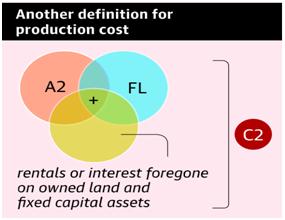

The farmers across India are protesting and one of main reason behind the farmers' protest is the Minimum Support Price (MSP) for crops which raises question on the cost of Production.
Context
The farmers across India are protesting and one of main reason behind the farmers' protest is the Minimum Support Price (MSP) for crops which raises question on the cost of Production.
About
- How the cost of agricultural produce is calculated?
Broadly, the costs are divided into two broad categories viz.
- Fixed costs: These are fixed. In agriculture, land in some sense is a fixed capital. The other important items of fixed costs are implements and tools, machinery, farm buildings, work animals etc.
- Variable costs: These costs vary with the production. One can increase or decrease their use. In agriculture, cost of seed, manure’s and fertilizers, irrigation, labour are the variable costs.
The sum of fixed costs and variable costs forms the ‘total cost’, when the total expenditure is deducted from the total returns (income), one gets the ‘net profit’.
How the different costs are categorized?
- Cost –A: Actual paid out costs for owner cultivator. This cost approximates the actual expenditure incurred in cash and kind and includes the following items:
-
- Hired human labour
- Owned and hired bullock labour
- Seeds
- Manures and fertilisers
- Implement charges
- Land revenew and other taxes
- Irrigation charges
- Other miscellaneous charges
- Cost –A-1: Corresponding cost for the tenant cultivator, i.e. including rent actually paid by him.
- Cost –A-2: Cost A plus imputed value of own labour.
- Cost – B: Cost A plus rental value of owned land and imputed interest on demand capital.
- Cost – C: total of all cost items, actual as well as imputed.
How is MSP Calculated?
- The Commission for Agricultural Costs & Prices (CACP) in the Ministry of Agriculture would recommend MSPs for 23 crops.
- These included 14 grown during the kharif/post-monsoon season and six in rabi/winter (wheat, barley, chana, masur, mustard and safflower), apart from sugarcane, jute and copra.
- The CACP considered various factors while recommending the MSP for a commodity, including cost of cultivation.
- It also took into account
- the supply and demand situation for the commodity
- market price trends (domestic and global) and parity vis-à-vis other crops
- implications for consumers (inflation), environment (soil and water use)
- terms of trade between agriculture and non-agriculture sectors
|
Swaminathan Committee
|
The ‘Price Policy for Kharif Crops: The Marketing Season 2018-19’ of the CACP stated the given 1.5 times formula to calculate the MSP:
- 5 times MSP Formula = 1.5 times the A2+FL costs



